Accepted Scientific Name: Astrophytum ornatum (DC.) F.A.C.Weber in Bois
Dict. Hort. [Bois] 1: 467. 1896 Bois

Echinocactus ornatus (Astrophytum ornatum) Photo by: Valentino Vallicelli
The Astrophytum ornatum is the largest and easiest to grow and also the fastest of the Astrophytums. Spherical when young to columnar when mature, some specimen develop nice twists with age. Ribs have characteristic cross bands of wooly scales.
Origin and Habitat: Astrophytum ornatum is the southern genus of Astrophytum. The habitats are at Hidalgo, Queretaro, San Luis Potosí and Guanajuato in Mexico(extent of occurrence less than 8500 km2). In San Luis Potosí there is a hybrid zone with other Astrophytum species.
Altitude: It grows at altitudes between 800 and 2000 metres above sea level.
Habitat: It is locally abundant yet patchily distributed in semidesert xerophile scrub. It grows mostly in wild canyons and limestone cliffs sometime on near vertical rockfaces, it can also grow on rocks in deciduous forests. Its distribution in canyons is due to the specific parameters of humidity and temperature that are necessary for its growth and reproduction. Habitat destruction due to trampling from livestock (goats), land-use changes, mining, and illegal collection are the predominant threats. The same areas support endemic succulents and xerophyte plants such as with Lophophora diffusaSN|1749]]SN|1749]], Mammillaria herrerae, Mammillaria parkinsonii, Coryphantha radiansSN|3914]]SN|3914]], Strombocactus disciformisSN|2103]]SN|2103]], Echinocactus grusoniiSN|10372]]SN|3345]], Ferocactus echidneSN|1690]]SN|1690]], Echinocactus ingensSN|3345]]SN|10372]], Myrtillocactus geometrizansSN|8050]]SN|8050]], Stenocereus dumortieriSN|7942]]SN|7942]], Cephalocereus senilisSN|6893]]SN|6893]], Agave strictaSN|27883]]SN|568]], Agave salmianaSN|568]]SN|27883]] and many other.
Synonyms:
See all synonyms of Astrophytum ornatum
back
Accepted name in llifle Database:Astrophytum ornatum (DC.) F.A.C.Weber in BoisDict. Hort. [Bois] 1: 467. 1896Synonymy: 23
Cultivars
(4):
back
Common Names include:
ENGLISH: Monk's Hood, Star Cactus, Ornamented Bishop's Cap
ARABIC ( لعربية ): أستروفيتم أورناتم
GERMAN (Deutsch): Sternblüher, Sternkaktus
JAPANESE (日本語): Han-nya, ハンニャ, Kinsi-han-hya
LITHUANIAN (Lietuvių): Puošnusis žvaigždinas
RUSSIAN (Русский): Астрофитум украшенный
SPANISH (Español): Visnaga, Liendrilla, Algodoncillo, Piojosa
SWEDISH (Svenska): Prickkaktus
Description: Astrophytum ornatumSN|3660]]SN|3660]] is a shortly columnar cactus appearing star-shaped from above, with white cross bands of woolly scales. It appears to be a very variable species especially for the density and distribution of white scales. It is the largest and easiest to grow and also the fastest of the astrophytums. It is also generally more heavily spined than other Astrophytums.
Stem: The stem is solitary, globose when young , cylindric with age, 30 to 120 cm (or more) high, 15-30 cm across, greyish-green to dark-green with more or less dense white or yellow woolly flakes in bands forming an ornate pattern.
Ribs: It has 5 to 10 (generally 8) straight or frequently spiralling, rather prominent, strongly compressed, more or less sinuate and crenate .
Areoles: 1 to 5 cm apart, at first yellowish-white felted, later grabrescent.
Radial spines: 5-11 stout, 2-4 cm long usually straight, subulated or ± laterally compressed, amber yellow, later brown and finally grey.
Central spine: usually 1 rather larger.
Flowers: At apex, large, lemon-yellow 7-12 cm broad, inner perianth segments broadly oblong, with a broad, more or less serrated apex, tube short woolly, scale on ovary, dark and very narrow.
Subspecies, varieties, forms and cultivars of plants belonging to the Astrophytum ornatum group
Bibliography: Major references and further lectures
1) James Cullen, Sabina G. Knees, H. Suzanne Cubey “The European Garden Flora Flowering Plants: A Manual for the Identification of Plants Cultivated in Europe, Both Out-of-Doors and Under Glass” Cambridge University Press, 11/Aug./2011
2) David Hunt, Nigel Taylor “The New Cactus Lexicon” DH Books, 2006
3) Edward F. Anderson “The Cactus Family” Timber Press, 2001
4) Sánchez , E., Guadalupe Martínez, J. & Bárcenas Luna, R. 2013. Astrophytum ornatum. In: IUCN 2013. IUCN Red List of Threatened Species. Version 2013.2. <www.iucnredlist.org>. Downloaded on 20 February 2014.
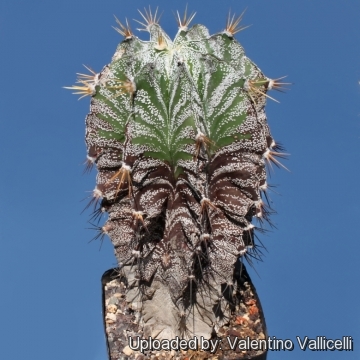 Echinocactus ornatus (Astrophytum ornatum) Photo by: Valentino Vallicelli
Echinocactus ornatus (Astrophytum ornatum) Photo by: Valentino Vallicelli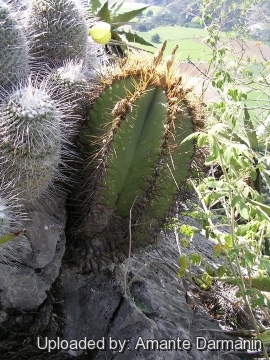 Astrophytum ornatum, in habitat at San Cristobal, Hidalgo. (Astrophytum ornatum) Photo by: Amante Darmanin
Astrophytum ornatum, in habitat at San Cristobal, Hidalgo. (Astrophytum ornatum) Photo by: Amante Darmanin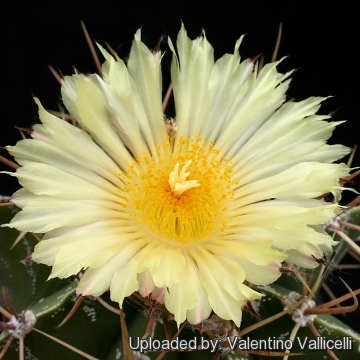 The flowers (6-8 cm wide) are pale yellow with bright silken sheen and scented. (Astrophytum ornatum) Photo by: Valentino Vallicelli
The flowers (6-8 cm wide) are pale yellow with bright silken sheen and scented. (Astrophytum ornatum) Photo by: Valentino Vallicelli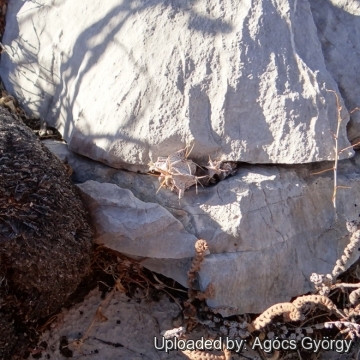 Young specimens growing in the rocks (Queretaro, Mexico) (Astrophytum ornatum) Photo by: Agócs György
Young specimens growing in the rocks (Queretaro, Mexico) (Astrophytum ornatum) Photo by: Agócs György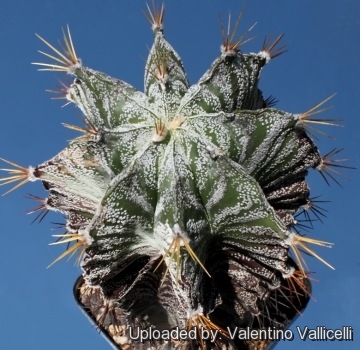 Echinocactus ornatus (Astrophytum ornatum) Photo by: Valentino Vallicelli
Echinocactus ornatus (Astrophytum ornatum) Photo by: Valentino Vallicelli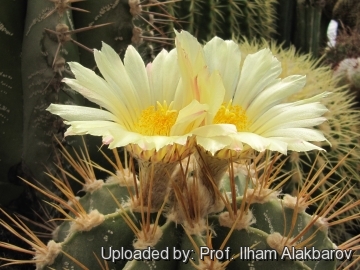 Echinocactus ornatus (Astrophytum ornatum) Photo by: Prof. Ilham Alakbarov
Echinocactus ornatus (Astrophytum ornatum) Photo by: Prof. Ilham Alakbarov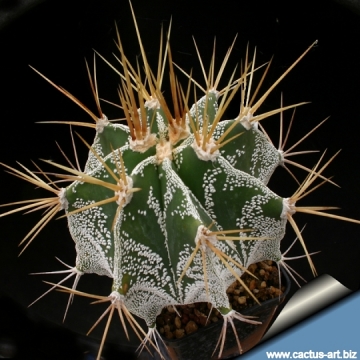 The body can be dark green with very few silvery felty "scales", or can be densely covered so as to appear nearly white. (Astrophytum ornatum) Photo by: Cactus Art
The body can be dark green with very few silvery felty "scales", or can be densely covered so as to appear nearly white. (Astrophytum ornatum) Photo by: Cactus Art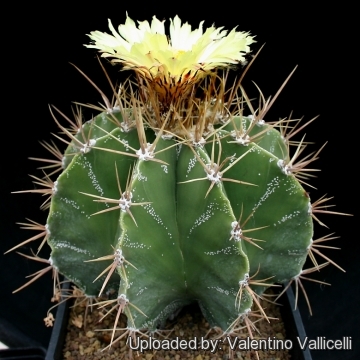 Echinocactus ornatus (Astrophytum ornatum) Photo by: Valentino Vallicelli
Echinocactus ornatus (Astrophytum ornatum) Photo by: Valentino VallicelliCultivation and Propagation: It is a popular summer-growing species of relatively easy cultivation.
Growth rate: Slow-growing. It needs to be at least 15 cm tall to bloom . This might take 7 to 12 (or more) years depending on the length of the growing period in the local climatic conditions.
Soil: Grow it in an open standard, sandy-gritty cactus compost and provide a very good drainage.
Exposure: It is suited for sunny-brightly exposure, but can tolerate light shade. However it will do its best with lots of sun and become stressed with inadequate light which could result in poor growth and unnatural shape. It has a good heat tolerance.
Watering: Water regularly (about once a week) during the growing season and keep it completely dry during winter or when night temperatures remain below 10° C. Water it less than average if in bigger pots.
Fertilization: Feed them once during the growing season with a fertilizer specifically formulated for cactus and succulents (high potash fertilizer with a dilute low nitrogen), including all micro nutrients and trace elements diluted to ½ the strength recommended on the label. They thrive in poor soils and need a limited supplies of fertilizer to avoid the plants developing excess vegetation, which is easily attacked by fungal diseases.
Special need: It is suited for airy exposures. Provide very good ventilation. Nearly all problems occur as a result of overwatering and poor ventilation, especially when weather conditions are dull and cool or very humid. ere.
Hardiness: It likes warmth (recommended minimum winter temperature 5° C) But plants kept perfectly dry can easily survive to light frost (it is reported hardy to -12 ° for brief periods).
Pests & diseases: These cacti may be attractive to a variety of insects, but plants in good condition should be nearly pest-free, particularly if they are grown in a mineral potting-mix, with good exposure and ventilation. Nonetheless, there are several pests to watch for:
- Red spiders: Red spiders may be effectively rubbed up by misting the plants from above.
- Mealy bugs: Mealy bugs occasionally develop aerial into the new leaves and flowers with disfiguring results, but the worst types develop underground on the roots and are invisible except by their effects.
- Scales, thrips and aphids: These insects are rarely a problem.
- Rot: Rot is only a minor problem if the plants are watered and “aired” correctly. If they are not, fungicides won't help all that much.
Propagation: It can be propagated easily from seed (seldom produces offsets). The seeds can be sown in pots of fine, well-drained sandy soil, any time during the spring when temperatures are warm. Cover the seeds with a fine layer of grit and water from below with a fungicide to prevent damping off. For the 1-2 weeks cover the pots with a sheet of glass/clear perspex to keep the humidity levels high. Remove the glass and replace it with light shade-cloth and mist once or twice a day for the next two weeks after which most seeds should have germinated. From then on mistings can be reduced to every second and then every third day as the little plants grow. The seedlings should not be disturbed until they are well rooted after which they can be planted separately in small pots. Sometimes it is grafted to avoid root rot problems as plants grafted on an hardy stock are easy to grow and no special skill is required.
Your Photos

by Cactus Art

by Valentino Vallicelli

by Cactus Art






















